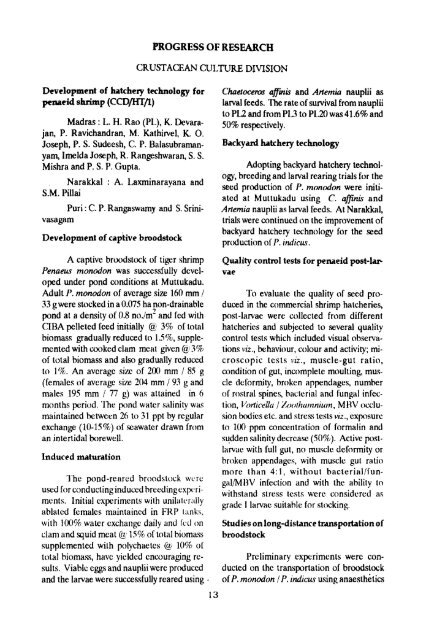annual report - Central Institute of Brackishwater Aquaculture
annual report - Central Institute of Brackishwater Aquaculture
annual report - Central Institute of Brackishwater Aquaculture
You also want an ePaper? Increase the reach of your titles
YUMPU automatically turns print PDFs into web optimized ePapers that Google loves.
PROGRESS OF RESEARCH<br />
CRUSTACEAN CUI-TURE DI1'ISIOP.j<br />
Development <strong>of</strong> hatchery technology for<br />
penacid shrimp (CCD/HT/l)<br />
Madras : L. H. Rao (PL), K. Devarajan,<br />
P. Ravichandrm. M. Kathirvel, K. 0.<br />
Joseph, P. S. Sudeesh, C. P. Balasubramanyam<br />
Imelda Joseph, K. Rangeshwaran, S. S.<br />
Mishra and P. S. P. Gupta.<br />
Narakkal : A. Laxminarayana and<br />
S.M. Pillai<br />
Puri : C. P. Rangaswny and S. Srinivasagam<br />
Development <strong>of</strong> captive broodstock<br />
A captive broodstwk <strong>of</strong> tip shrimp<br />
Penneuc monodon was successfully dcveloped<br />
under pond conditions at Muttukadu.<br />
Adult 1'. tnonodon <strong>of</strong> average sim 160 mm /<br />
33 g were stocked in a O.075 ha non-drainable<br />
pond at a density <strong>of</strong> 0.8 no./m2 and fed with<br />
CIBA pclleted feed initially @ 3%. <strong>of</strong> total<br />
biomass gradually reduced to I.?%, supplemented<br />
with woked clam mcitl given @ 3%<br />
<strong>of</strong> total biomass and also gradually reduced<br />
to 1%. An avcrage six (<strong>of</strong> 200 mm ! 85 g<br />
(femalcs <strong>of</strong> avcragc sife 204 mm 193 g and<br />
males 195 mm :' 77 g) was attained in 6<br />
months period. 'Ihr pond water salinity \ras<br />
maintained betwecn 20 to 31 ppl by regular<br />
exchange (10-IS(#!) <strong>of</strong> seawater drawn from<br />
an intertidal borewell.<br />
Induced maturation<br />
The pond-reared broodstock ii8i re<br />
used for conducting induced breedingcxpcrimcnts.<br />
Initial cxpriments with uni1atcr:lIl)<br />
ablated females maintained in I'ItP (:ink\,<br />
with l(J0'X water exchange daily and lctl on<br />
clam 2nd squid meat Q 154 <strong>of</strong> total biom;lss<br />
supplemented with polychaetcs @ 10% ol<br />
total biomass, have yielded encouraging results.<br />
Viable eggs and naupliiwere prtduced<br />
and the larvae were successfully reared using .<br />
Chaetocem affutis and Anemia nauplii as<br />
larval feeds. 'he rate <strong>of</strong> survival from nauplii<br />
to PU and from PLY to YL.20 was 41.6% and<br />
50% respectively.<br />
Backyard hatchery technology<br />
Adopting backyard hatchery technology,<br />
hreeding and Iawal rearing trials lor the<br />
seed production <strong>of</strong> 1'. monodon were iniGated<br />
at Muttukiidu using C. affinis and<br />
Aaemra nauplii as liiwal feeds. At Narakkal,<br />
trials were continued on the improvement <strong>of</strong><br />
backyard hatchery technology for the seed<br />
production <strong>of</strong> 1'. rrulrcu.\.<br />
Quality control tesb for penaeid post-lar<br />
vae<br />
'10 evaluate the quality <strong>of</strong> seed produced<br />
in the commercial shrimp halcheries,<br />
post-larvae were collected from different<br />
hatcheries and subjected to several quality<br />
control tests which included visual obsewalions<br />
vu., khaviour, colour and activity; microscopic<br />
tests rrz., muscle-gut ratio,<br />
condition <strong>of</strong> gut, incclmpletc moulting, mus.<br />
cle deformity, broken appendages, number<br />
ol rostra1 spines, bacterial and lungwl infcction,<br />
l'orirceUa 1 %oo~itut~tn~u~n, MIIL' occlusion<br />
bodies etc. and stress tcsts vrz., exposure<br />
to 1(Kl ppm concentr;~tion <strong>of</strong> formalin and<br />
sudden si~linity decrease (SO%). Aclivc postlarvae<br />
with full gut, no muscle deformity or<br />
broken appndagc~, with muscle gut ri~tio<br />
morc than 4: 1, witbout bacterialllunpal!MHV<br />
inlection and with the ability to<br />
withstitnd stress test5 were considered<br />
grade I larvae suitable for stxking.<br />
Studiesonlong-distancetransportation<strong>of</strong><br />
broodstock<br />
Prcliminiiry expcrirncnta werc conducted<br />
on the transportation <strong>of</strong> broodstwk<br />
<strong>of</strong>P. monodon IP. indicus using anaesthetics

















